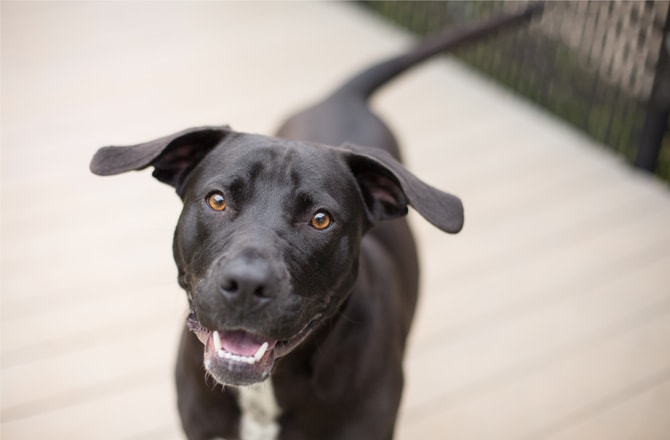It can be hard not speaking the same language as your best friend. While we like to think we know what’s going on in our dogs’ heads, the truth is, plenty gets lost in translation. So what does your dog really want you to know? From tail wags to puppy eyes, the experts explain what your dog might be trying to tell you.
“I don’t feel guilty.”

Thanks to the popular “dog shaming” Instagram trend, guilty-looking dogs are everywhere these days. But according to Kris Crestejo, a certified dog behavior consultant, your dog doesn’t actually experience the emotion—at least not how we humans understand it.
Instead, that “guilty” look—avoiding eye contact, hiding, blinking in excess—is actually an appeasement signal aimed at calming you down and avoiding punishment. In short, he’s simply afraid and confused.
“People anthropomorphize dogs quite a bit,” says Crestejo. “We give them so much credit for being masterminds, but fail to recognize if the dog is so smart and understands they’re going to get into trouble for a behavior, why would they do it again and again? To make their human, the people they love most, super mad for fun? That makes no sense.”
And with that, #dogshaming is officially ruined for us.
“I can’t act spiteful.”

Again, spite is a uniquely human emotion. Unlike your two-legged roommates, canine companions aren’t capable of deliberately offending you in retaliation.
“I often have clients who believe their dog is acting out of spite or anger when something happens while the owner is away from home—defecating in the house, destroying a pillow or chewing up the reading glasses,” says author and certified dog behavior consultant Sue Brown. “Most often the behaviors they see have a very clear reason, but not the one they thought.”
What gives? According to Brown, destructiveness is a common symptom of separation distress or anxiety, not anger. In other instances, your dog may simply be bored—and when you’re a dog, dissecting a throw pillow is always a good way to pass time.
“I know that you’re late.”

We’ve all heard that dogs don’t experience time the same way that we do. But while they can’t read a clock, they’re very in tune to patterns, which means they know you’re late getting home from work.
“Dogs can tell changes in the environment that trigger certain events to happen,” says Crestejo. “Living in a suburban neighborhood, there are events that happen every single day: household wakes up, school bus comes, kids leave, parents leave, school bus comes, door unlocks, kids come in, parents come in, dinner is served, walk, cuddles and sleep.”
In other words, pack up your desk when possible because your dog notices when his favorite people miss their cue.
“I understand more than you think.”

Your dog can’t speak English, but he knows how your day went. While lacking in vocabulary, dogs are masters of tone and body language.
“Sometimes I think our dogs know what we are feeling better than we do” says Brown. “That’s one of the reasons that dogs have thrived so well living among humans—they’re excellent at reading us.”
When working with clients, Brown encourages them to focus not just on the command word, but on the tone of their voice as well.
“You might think you’re telling your dog to ‘come’ because that’s the word you’re saying,” she says. “But if your tone of voice and body language indicate you are angry or upset, your dog is reading the message to give you space.”
“Your smoking is bad for my health.”

Dogs can’t read the latest studies, but if they could, they’d encourage you to stop smoking cigarettes. Research shows that dogs exposed to second-hand smoke experience a variety of health problems, including respiratory diseases, lung cancer and nasal cancer. The same is true for cats, who are even more vulnerable from grooming their smoke-infused fur.
“My tail wags aren’t always happy.”

A wagging tail is a happy tail, right? Not always. Although many wags are good natured, others act as warnings or stress signals.
“The wagging tail is one of the easiest signals to misinterpret” says Brown, who notes that some dogs will wag their tails as they bite. “Though the tail can give us some good information, if we only look at the tail, we might be missing something important. It’s sort of like saying that anyone who smiles is happy—as we know, that’s not always the case.”
To better assess what your dog is trying to tell you, Brown recommends taking all of his body language into consideration, as well as the positioning of the tail (low wags tend to be more fearful than happy) and speed (slower wags indicate caution).
“I’m not excited about summer festival season.”

As the weather warms up, it can be tempting to bring your pup along for summer outings. But while you’re having a great time at the fairs, block parties, parades, picnics and farmer’s markets, he may not be.
“Crowds and festivals can be stressful for dogs because of the noise, unwanted interactions with unfamiliar people and unfamiliar dogs,” says author and certified animal behavior consultant Jane Bowers. “The noise from outdoor festivals can make dogs feel anxious, perhaps because they hear much better than humans do.”
If you do bring your dog along, pay close attention for any signals that he may be stressed and needs some space, advises Bowers. After all, he can’t quite call his own lift home.
“I’m not a troublemaker, I just need to get some exercise.”

Unfortunately, your dog can’t send you a text and ask if you want to hit up Pilates later. Instead, he’ll likely show you how much energy he has to burn off.
“If a dog doesn’t get enough exercise overall you may see problem behaviors emerge,” says Bowers. “For example, a dog may chase things that are inappropriate or become destructive. They may bark for attention, dig or show hyperactivity.”
For a more relaxed dog (and peaceful home), make sure to provide plenty of opportunities for both physical and mental exercise, Bowers says. Teaching him some new tricks or doing agility training can accomplish both at the same time.
“I’m not necessarily a cuddle bug.”

Last spring, a rather devastating headline hit the news cycle: “Dogs Don’t Like to Be Hugged.” In a widely-cited blog post for Psychology Today, Dr. Stanley Coren analyzed 250 pictures of people hugging dogs on the Internet and concluded that, in the majority instances, the dogs were showing clear signs of stress and anxiety. They weren’t feeling the love—they were simply feeling trapped.
So, does your dog enjoy cuddle sessions as much as you do? If you don’t know, simply ask, says Caroline Spark, a certified animal behavior consultant.
“When you stop cuddling, what happens? Lip licking, turning away, shaking off, moving as soon as you stop, not coming back for more—these are all signs that cuddles aren’t your dog’s favorite thing,” she says. “If your dog leans in and snuggles up, paws at you or comes back for more, you have a cuddle hound!”
Regardless of your dog’s snuggling preferences, Spark says that young children shouldn’t give hugs to dogs. If the dog does become stressed and reacts, a child’s face is right at bite height.
“I’m an individual.”

Dogs of the same breed will share some similar characteristics, that much is true. But at the end of the day, your dog is unique and you have to get to know his preferences, fears and needs. Trying to decode his behavior based on previous pets simply isn’t enough.
“One of the things I try to teach dog owners is to see their dog as an individual,” says Lisa Mullinax, a certified dog behavior consultant. “Every dog, regardless of breed, has their own unique combination of genetic predisposition, experiences during early development, learning history and more. Even if you’ve had forty German Shepherds in the past, your forty-first German Shepherd is unique.”

Monica Weymouth is a writer, editor and certified Weird Animal Lady. She lives in Philadelphia with her two rescued Shih Tzus.
Share:









